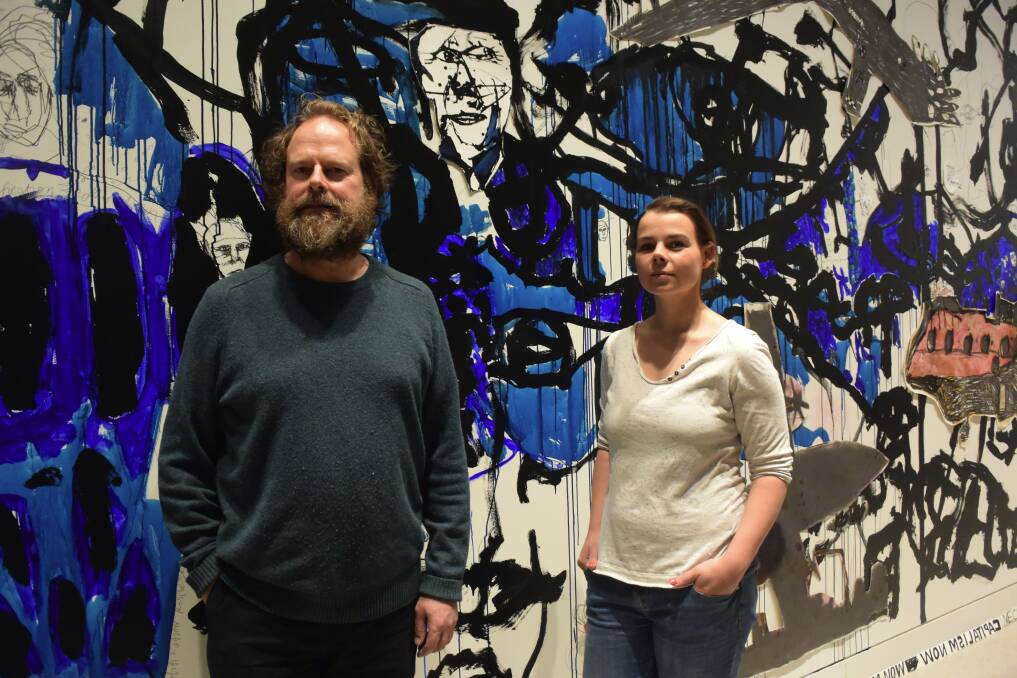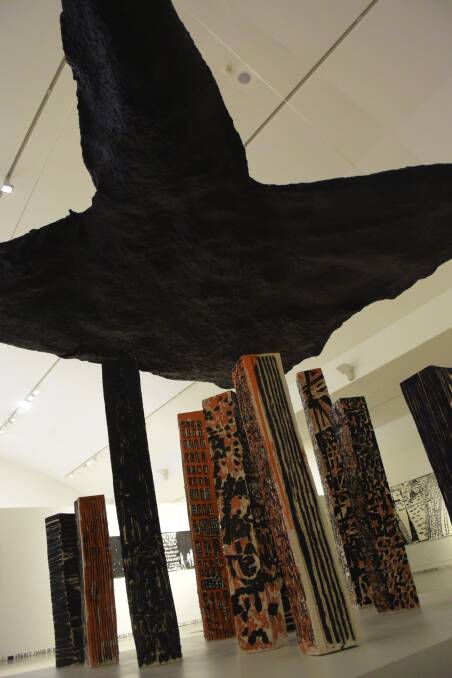

His life, his views and his art are every bit as extraordinary as his name.
Katoomba's Locust Jones has his first exhibition at the Blue Mountains Cultural Centre opening this month.
The work of this New Zealand-born, Blue Mountains-based painter is big, frenetic and endless.
There's an ominous 200kg drone made up of metal and newspaper pulp flying overhead- "it needed a council truck just to get it from Locust's home", said exhibition manager Sabrina Roesner. Included in the display is a 10m-long scroll running from the ceiling to the floor filled with narratives of catastrophe and death that Jones had heard on the news.
The exhibition A Week in the Life of the World - a title direct from a tagline in The Guardian Weekly newspaper - also has the distinction of being the first to be painted directly onto an entire wall in the city's pristine white art gallery.
Last week the room was shut while Jones spent two days covering metres of the wall in rushes of black and blue ink and pencil.
"I could easily have kept going, it would be great to have the whole space," the media-shy artist told the Gazette in a rare interview last week.
When the exhibition ends in September someone will have the three-day-long job of painting over his amalgam of ideas, grimacing figures and scrawled comments about global financial crises, puppet governments, famines and Bronwyn Bishop's helicopter ride.
"People will have to take it as it comes [the exhibition]. And that's what they have had to do all my life. It's like the name Locust, like a plague, I leave this trail of destruction. Maybe that's why sometimes life is not always so hunky dory. I've sort of created this monster."
While Jones, 52, seems to abhor the nature of the news cycle which informs his work, he's also slightly addicted to it.
"I have the radio on or live webstream from Al Jazeera while I work. I am permanently plugged into the chaos of the day [and] try to make sense of the big picture."
And part of his artistic reasoning is to help others wake up and smell that chaos.
"I know a lot of people don't even listen to the news. It makes them depressed. It's a little bit naive to think you can live in a bubble. We are all in the world."
As a child growing up on a farm, Jones saw a lot of death.
"There was lots of killing of animals, from rabbits to pigs and ducks. I grew up with guns and rifles. It was not the chocolate box New Zealand you see in tourist brochures."
He also vividly remembers taking home a loaded German Luger pistol as a seven-year-old child. He found it after visiting a deceased estate with his parents.
"It was still in its holster and had a magazine inside it which I hid from my parents."
He also remembers hearing about the Vietnam and Lebanese civil wars as a child, and then visiting war zones as an adult.
"From those early childhood memories I got this taste for what was happening on the other side of the world," he said.
And what of that extraordinary name?
Rumours abound that he was a pest as a child and the name Locust stuck, or that he was named after Revelations as something of a harbinger of doom, carrying a plague of bad news, but Jones reveals a much more surprising answer, saying it stemmed from the moment of his arrival into the world.
"My Dad was quite into LSD in the 60s and when I was born and my mother was giving birth in a teepee he saw a plague of locusts and he said 'Locust, that's my son'.
"It's true."
Locust Jones' work is represented in public collections including the National Gallery of Australia, Art Gallery of South Australia and the Shepparton Art Museum.
Details: bluemountainsculturalcentre.com.au.

